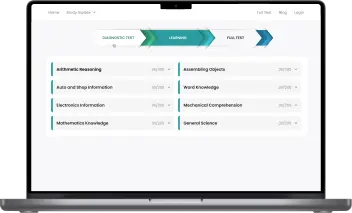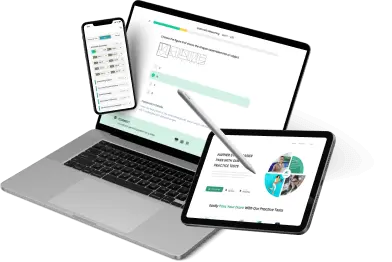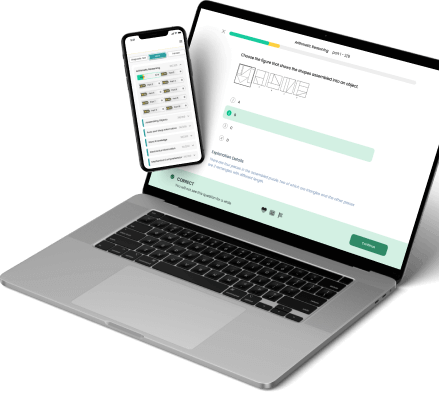Fun & effective CCAT practice test tool to pass with flying colors
All-in-one platform with everything you need to ace the CCAT on your first attempt
Clear and Thorough Learning Path
Proven CCAT 3-step Practice Formula
After our 100,000+ users' success stories, we developed a 3-step strategy to provide you with the most precise and in-depth learning path while minimizing your prep time.CCAT Diagnostic Test
First, take this short test and get your detailed report showing your strong and weak areas. Save your time by concentrating on what is in demand.Learning
With quick, bite-sized learning techniques and a detailed study guide for each CCAT section, you can really strengthen your weaknesses (from step 1) and boost your scores.CCAT Full Test
The last step for your preparation is taking our full CCAT practice tests and seeing how far you've come since the beginning. Repeat the 3-step formula until you are satisfied with your results!Ready to start?
Thousands of CCAT users already accomplished their goals.NOW it’s your turn!

What You Get

All-in-one platform
A complete CCAT Prep Platform, including a diagnostic test, detailed study guides for all topics, practice questions with step-by-step explanations, and various full simulator tests.
Questions nearly identical to those in the real CCAT test
All questions are categorized into the specific sections as on the real CCAT: Same format & same difficulty!
Best for the busy
Easily & quickly grasp all the knowledge with our unique learning technique. And you can learn anytime, anywhere on any devices, even with a few free minutes.
Practice while having fun
Learn and play! Complete round-by-round to reach your daily achievement and make progress on your learning journey!Featured on















What our users are saying
Over 50,000 aspiring American candidates use CCAT monthlyIt may seem difficult to find the employee that best fits your company's culture and work ethic today, which is why it is well worth thoroughly screening applicants using the CCAT Test. Too often, businesses are quick to seize the chance to recruit someone who first looks to be an excellent hire but who, over time, proves to be much less than anticipated or even disastrous in the long run.
The process of screening prospective personnel, on the other hand, might be challenging. You won't be able to get a true picture of a candidate's capabilities and potential no matter how many personal interviews you do. Because of this, every company has started using pre-employment assessment tests like the CCAT to assist them in attracting the correct kind of workers to work for them.
In the following sections, we will discuss what the CCAT Test is, what you should anticipate from taking it, and how you can make the most of the information you get from it.
What is the CCAT Test?
The Criteria Cognitive Ability Exam, often known as the CCAT, is a psychometric test that is used to evaluate an individual's psychological capabilities. A candidate's ability to address problems or engage in critical thinking will be evaluated with this exam. In most cases, the CCAT will evaluate a candidate's cognitive abilities by taking into account a number of different aspects, such as their learning speed, problem-solving ability, and critical thinking.
It is typical practice for recruiters to administer this kind of pre-employment exam to applicants to establish whether or not a certain job position is a suitable match for a candidate. Following the completion of the exam and analysis of the results, a profile report is generated and then sent to the recruiter. If a recruiter uses CCAT, there is a greater probability that they will hire the applicant who is the best fit for the job they are trying to fill.
People who have high potential are much more inclined to learn new things quickly and excel in their performance, in comparison to people who have a low aptitude. The CCAT has 50 questions, and very few individuals can complete all 50 questions within the allotted period of 15 minutes. The Comprehensive Computerized Aptitude Test (CCAT) is one of the most widely used job aptitude exams in the United States, having been administered more than 5 million times.
What is the Purpose of the CCAT Test?
The cognitive ability exam assists recruiters in determining not only what talents they have gained from prior employment but also how they might apply those abilities to a new career. The CCAT, when paired with an in-person meeting and a review of your work history, provides the employer with a more comprehensive knowledge of your capabilities and allows them to establish the tone for the rest of the hiring process.
The cognitive ability test is becoming more popular among employers. This is mostly because it may assist employers with the process of training and onboarding new employees by providing them with an indication of the candidate's capacity to acquire new skills and knowledge. Each subcategory of inquiry may provide hiring managers with information on a candidate's rate of learning and their capacity for logical reasoning, both of which are essential skills for a variety of positions.
The potential to save time and money is another advantage of taking the CCAT exam. Doing the test can save both recruiters and applicants time if the candidates' cognitive ability doesn't really match the position they are conversing for. This is especially helpful in fields such as technology, accounting, and finance, where the interview process can be lengthy and involve multiple rounds. The sooner a candidate finds out that they will not be selected for the post, the sooner they may concentrate their efforts on submitting another application.
What’s the Format of the CCAT test?
There are a total of 50 questions on the CCAT, and test takers have a maximum of 15 minutes to answer all of the questions. As a result, it is anticipated that the test-takers would provide answers to as many questions as they can. Because of the time constraint, the majority of candidates won't be able to complete their questions. The CCAT assesses a candidate's ability to think verbally, numerically, and spatially via the use of multiple-choice questions. In addition, contestants are prohibited from using calculators throughout this examination.
The questions on the CCAT exam are organized in the following order:
Spatial Reasoning (including a total of 11 questions)
Questions involving spatial thinking are prevalent on the CCAT, as they are on IQ tests as well. The goal of evaluating these skills is to see how fast you can recognize new patterns and pieces of information before comprehending and using them. Results from spatial reasoning tests are significant to employers when evaluating a candidate's capacity for critical thought.
Numerical reasoning (including a total of 17 questions)
A pre-employment CCAT test's main focus is on logical questions, which might make some people feel like they've been sent straight back to school. The ability to think numerically, which is highly prized in the contemporary world, is shown by those who do well on math and logic examinations. The examinations are not extremely challenging, but because calculators are not allowed, the applicant must only utilize their natural intelligence.
Verbal Reasoning (including a total of 17 questions)
The importance of communication in the workplace cannot be overstated. Effective communication and transmission of ideas, as well as the ability to give modifications and perspectives on issues, are critical components of being a valued employee, and this is precisely what is examined during a CCAT. During the exam, the verbal questions mainly measure a candidate's ability to inherently comprehend the precise meaning of words as well as their context.
Nevertheless, the question categories may be mixed or arranged, as presented above. Keep in mind that 50 questions are a very frightening quantity of questions to tackle in just 15 minutes. But once you know how the exam is structured, you'll find that it's not quite as difficult as it may seem at first. To begin, it is not required of you to really answer all 50 questions correctly. Second, as soon as you begin to practice and become used to the different types of questions and the time limits, you will see how things begin to become clearer to you.
What to Expect on the CCAT?
As mentioned above, the CCAT consists of 50 questions that cover a variety of subjects, including verbal reasoning, mathematics, and reading comprehension. You will only have 15 minutes to answer as many questions as you can, and based on the results of previous tests, just one percent of applicants manage to answer all 50 questions correctly. If you are unable to answer all of the questions, you should know that you are not alone.
In a word, the goal of the CCAT is not to get the questions correctly; rather, it is to complete the test. That is if you admit that some of the questions on the exam cannot be done in the allotted amount of time, and if you permit yourself to skip those questions, you will be able to go forward with the test and choose additional questions that are relevant to your areas of expertise. We can guarantee that if you put in the effort to perfect this ability and get your mind into the appropriate frame of mind, you will be successful.
It is important to remember that the CCAT is just one of the variables that will be considered by recruiters; thus, you should refrain from worrying too much about the test since it is only one part of the recruitment process.
How Is the CCAT Scored?
After you have finished the test, your raw score as well as your percentile ranking will be forwarded to the person in charge of recruiting. Your raw score is determined by the number of questions that you answered correctly. Your performance on the exam about that of the other people who took it is represented by your percentile.
Your CCAT test results will be displayed on the front of your test in a numerical and chart format, as well as in the form of percentiles about more particular areas, such as spatial reasoning. In brief, if your percentile rank was 45, it would indicate that you performed better on the exam than 45 percent of the other people who took it.
The kind of job for which you are applying will dictate the scoring method that will be used. For instance, the minimum score required for a senior management function will be different from the minimum score required for a more junior or middle-level position. In most cases, the total average score is 24 out of 50. If, on the other hand, you are seeking a more senior position in a sector such as technology or finance, it would be beneficial to have a score of at least 30 out of 50. If you scored between 35 and 45, you would be considered to be in the top 30 percent of the class.
Some instances of score variations, broken down by industry, are as follows:
- Computer Programmer – ranging from 23 (low) to 40 (high)
- Financial Analyst – ranging from 23 (low) to 38 (high)
- Network Administrator – ranging from 23 (low) to 37 (high)
Your scores are quickly computed, and as soon as you have finished the test, your findings will be delivered straight to the recruiting manager who prompted the examination in the first place. On the second page of your report, it will display how you fared in comparison to the predicted ranges that Criteria Corporation had established for the different responsibilities. While some companies may walk you through the test and give comments on your performance, others may take a more understated approach.
Is the CCAT Test Hard?
As a result of the fact that the CCAT is mostly taken by job applicants who are applying for high-profile jobs, it is natural to assume that the questions on the exam will be challenging to present individuals with above-average intellect with some amount of difficulty.
Having said that, people's experiences with the CCAT examinations have shown that they are not too challenging, particularly in comparison to those of other exams. If you have graduated from high school, it is generally agreed upon that you have a good probability of being able to work your way through some issues before reaching a point where you are stuck.
Candidates who sit for the CCAT have a high propensity to experience confusion following the first twelve questions they encounter. This is because very few individuals are equally competent in all 3 cognitive domains that are covered by the exam. This means that a person who is naturally gifted at utilizing words may, unsurprisingly, struggle when answering problems linked to logic.
If you are a candidate who is going to be put through a CCAT exam, then you need not be worried about it since just 10% of people who take the test answer more than 35 questions. It is fairly usual practice to swiftly address the issues to which you know the answers and then come back to those to which you do not know the answers. By doing so, you will save yourself important time and reduce your stress levels.
The level of difficulty of the examination rises with each question that you respond to; hence, even if the first few questions may seem simple, the ones toward the end of the exam are going to be noticeably tougher.
How to Pass the CCAT Test?
You may prepare yourself for the CCAT test in the same way that you would study for an exam. The tactics for enhancing your cognitive talents that were discussed before absolutely apply to this situation; in addition, here are several tips that will lead you to success:
Take the time to read the directions
Examinees who move too quickly through the instructions are responsible for the majority of the errors they earn. Bear in mind that you are free to spend as much time as you want in order to study and comprehend them! You may formulate a plan to get the greatest possible score based on the directions that have been provided. On the CCAT, there is no penalty for incorrectly answering any of the questions. It is recommended that you make an educated guess and go on to the next question if you are unable to answer a specific question.
Exercise the full-length mock examinations
It is recommended that you practice using full-length CCAT simulations that may be found on the internet to improve your score on the CCAT. You will get a realistic understanding of the exam, as well as the skills needed to do well on the test by completing the full-length practice. The actual exam consists of fifty questions, each of which must be completed within a time limit of fifteen minutes. Continue practicing until you can attain your desired score.
Learn only what matters and avoid unimportant problems
When you are preparing for the exam, you should solely concentrate on the particular sorts of questions that will be on it. You should avoid practicing general topics since it will simply serve to distract you and squander the time you have allotted for preparation. You don't need to practice any of the other sorts of questions since, for instance, there are only three different types of spatial reasoning questions on the test.
Focus on your strengths
For example, if you are more skilled with numbers than words, you should complete all of the mathematical problems first or give yourself extra time to complete them. In this approach, you will be able to devote more time to questions that you have a greater chance of getting right.
Acclimate yourself to the actual conditions
If you want to do well on the CCAT, you need to practice being able to work efficiently under time constraints, since this is the component of the exam that is considered to be the most important. Therefore, you should make an effort to finish at least a few full-length CCAT sample exams to gain a sense of the pressure that will be applied to the actual exam.
Do not revisit previous questions
Forget about skipping challenging questions to return to them at a later time; such a strategy won't work. Don't give in to the temptation to breeze through the questions too quickly; you won't be able to revisit any of the ones you've already answered. If after twenty seconds of working on a question you realize you are not making any headway, you should begin to eliminate potential solutions, make a guess, and then go on to the next question.
Keep energized
It may go without saying, but make an effort to maintain your energy level. This does not imply that you should drink an excessive amount of coffee; rather, it means that you should drink enough water and eat a nutritionally sound diet. You will be better able to think clearly and feel more prepared for the test if you do this. You definitely do not want to have a sluggish feeling before an exam.
CCAT Practice Test features
Free Practice Questions: 1000+ FREE CCAT practice questions with detailed explanations are available for all of the required skills. All you need to pass your recruitment test is available here.
CCAT Practice Tests Based On Real Tests: Same number of questions, same time limits, same structure. The exam simulators let you familiarize yourself with the test format and get totally ready for the real one.
No Sign-Up Or Login Required: All of your progress is saved without an account, even if you close your browser. But login can sync your data between web and mobile applications.
Gamification: The learning process will be divided into small milestones. Let’s make your studying exciting as if you were in some interesting games.
Personal Study Plan: Just enter your CCAT test date, and a study plan will be set up for you. A clear schedule will surely exceed your expectation and get you the best preparation for the reading shot.
3 Interesting Test Modes: 3 different test modes with increased difficulty levels let you experience the test in various ways.
Dark Mode: Experience a dark theme that is more friendly to your eyes, and get a whole new and marvelous experience.
No Internet Required: Study on the go conveniently without any Internet connection.
CCAT Test Bank: 3 features: Weak/ Medium/ Strong questions help you clearly determine which area you should pay more attention to.
FAQs About CCAT Test
Is the CCAT test an IQ test?
The CCAT exam is not recognized to be an IQ test in any way. The cognitive skills of a candidate are evaluated using the CCAT, whilst the applicant's intellectual quotient is determined using an IQ exam. The CCAT and IQ exams are not the same kinds of evaluation, though they have certain characteristics with one another.
On the CCAT, what is a good score?
This is something that will be determined by the job that you are applying for. The typical raw score on the CCAT is 24, based on the data provided by JobTestPrep. If you want to place yourself in a favorable position, it is recommended that you score in the top 20 percent of all applicants. You will need a raw score of about 31 to do this. If you get a score of 42 or above on the CCAT, you should feel confident applying for any of the jobs that it evaluates.
What is a passing score on the CCAT?
Every company decides on its own minimum acceptable score for the CCAT. Additionally, the minimum required score to pass will vary according to the nature of the position being applied for inside a business. If you get a score that is equal to or higher than the minimum requirement for the position for which you have applied, your application will probably be moved on to the next step of the recruiting process.
How should the results of the CCAT be interpreted?
In addition to a raw score and a percentile score, the results of the CCAT also include a breakdown of each area as well as proposed scoring ranges. The raw score is determined by how many questions out of a total of 50 you got right. For instance, if you have a raw score of 25, it indicates that you have properly answered 25 questions. The percentage score that you received indicates how well you scored in contrast to the other people who took the exam. For instance, if your score was 80 on the percentile scale, it indicates that you performed better than 80 percent of the other applicants.
Your performance in the Math and Logic, Verbal, and Spatial Reasoning sections is reflected in the breakdown score for each component. You will see how you fared in comparison to other applicants based on the percentile ratings that are provided to you for each breakdown.
The Bottom Line
Your score on the CCAT is only one of many factors that will be considered by potential employers when making a hiring decision; other factors include experience, education, and references. If your score on the CCAT is lower than what the company was looking for, it indicates that you are not a good match for the position. If you want to get to know yourself better and discover a career that's a good match for you, you may try taking several personality tests.
You have the option of suggesting to the recruiter the time of day that works best for you to take the examination. This ought to be the time of day when you feel the most energized and capable of getting things done. For illustration's sake, if you are not a morning person, you probably do not want to take an exam that requires you to evaluate shapes as soon as you get out of bed. Plan it during a time of day when your mind is at its most active so that you may get the most out of it.
When you are taking the test, you should make every effort to ensure that there are no interruptions. If you are going to take it at home, for example, you may study when your children are at school or while your roommates are at work. Because the exam only lasts for a quarter of an hour, you should make sure that you won't be distracted by anything else while you're taking it.
You should also know that there are numerous tools and sample tests available that may assist you in preparing for the exam; all you need to do is do some research, and you will be ready to go.






